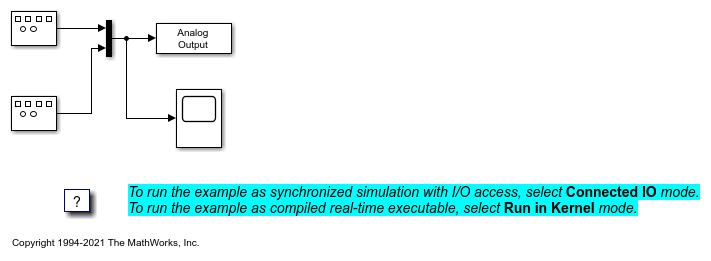Real-Time Signal Generator
This example shows how to produce an analog output signal by using Simulink® Desktop Real-Time™. Because analog output can require less configuration and is easier to connect than analog input, this model is useful for working with data acquisition boards. You can verify the presence of the generated signal, for example by connecting an oscilloscope to the analog output pins of your data acquisition board.
Note: To run this model, you must have a data acquisition board connected to your computer.
Run Model in Connected IO Mode
Open the Analog Output block and select your data acquisition board. If there is no board installed, install it by clicking the Install new board button.
To switch to Connected IO mode if needed, on the Desktop Real-Time tab, select Mode > Connected IO.
To start the real-time execution, click Run in Real-Time.
Run Model in Run in Kernel Mode
Open the Analog Output block and select your data acquisition board. If there's no board installed, install it by clicking the Install new board button.
To switch to Run in Kernel mode if needed, on the Desktop Real-Time tab, select Mode > Run in Kernel.
To start the real-time execution, click Run in Real Time.
The model builds, connects to Simulink in Run in Kernel mode, and starts.
Open the Model
open_system('sldrtex_siggen');

Close Open Scopes
close_system(find_system(gcs ,'BlockType', 'Scope'));
Clean Up the Model
clear close all bdclose('sldrtex_siggen')